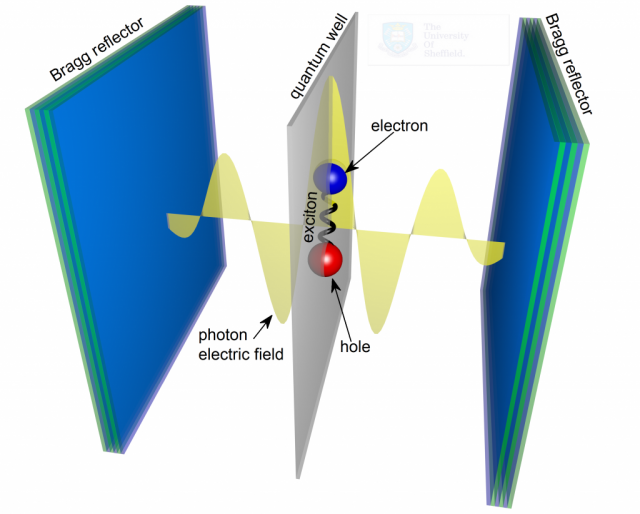What on earth is a polariton?
When I first started writing about condensed matter science I found some difficulties with a few purely physical concepts, being myself a chemist by education. One of those was ‘polariton’. After some years of reading solid state physics papers and writing about them on a weekly basis, now is a familiar term, but I still receive some comments asking what on earth a polariton is from readers (with a significant percentage of fellow chemists). What follows is a conceptal approach to an explanation, conceptual meaning with no mathematics.

Let’s start with the concept of mode. We know that bodies vibrate; the pattern of motion in a vibrating body is what we call mode. If the body has several component particles, such as a molecule consisting of several atoms, the modes of vibration are the different types of molecular vibrations possible. That simple.
But if the particles in a system interact with each other, the vibrating motion would be cooperative because of these interactions. The mode of oscillations would affect the whole collection of particles in the system. These collective oscillations, depending on the system that we consider, can be understood using either classical or quantum physics.
In the quantum theory of many-body systems, there is some kind of Freudian fixation with excitement and collective oscillations are called collective excitations. In a quantum context, everything is quantized. Hence, collective excitations become quantized modes because of the cooperative motion of the whole system as a result of interactions between particles. But not all collective excitations are associated to a ‘mechanical’ displacement, like a vibrating atom. They may be electronic excitations in atoms, and we will consider for the sake of the argument these so-called excitons.
We need to visualize excitons as something tangible in order to go on with this maths-free conceptual approach. For this purpose something similar to a hydrogen atom, consisting of a central positive charge, the proton, and a negative charge at some distance, the electron would be familiar enough. If we now consider an electron missing, a hole, a proton lookalike, an exciton can be described as an electron-hole pair in a crystal that is bound in a manner analogous to the electron and proton in a hydrogen atom. Thus, the exciton behaves like an atomic excitation that passes from one atom to another. Exciton energy states involve a band with a particular dispersion law that depends on the crystal properties.
But, how are excitons created in the first place? In most cases excitons are induced by an electromagnetic wave, a photon. So the more correct name for the resulting exciton in these cases would be photoexciton.
Interestingly, in some cases the frequencies of vibration of the incoming electromagnetic wave and the resulting exciton are very similar, and they resonate. When they have a strong resonance interaction with each other a quasi-particle results from the admixture of states of the photon and the exciton. This is our polariton. In this case there is no longer a sharp difference between the excitons and the photons in the crystal; hence, the speed of light through the crystal depends on the frequency, a characteristic of polaritonic substances.
In this excellent video from The University of Sheffield you can see the important ideas we have seen so far put together:
Now, we can go for a more general definition if we take into account that our exciton is no more than a dipole (two equal and opposite charges that are separated by a distance). Thus, polaritons are quasiparticles resulting from the strong coupling of photons with a dipole-carrying excitation.
It follows from this definition that there is a variety of polaritons depending on the dipole-carrying excitation. Some of them are:
- Phonon polaritons result from coupling of an infrared photon with an optic phonon;
- Exciton polaritons result from coupling of visible light with an exciton;
- Intersubband polaritons result from coupling of an infrared or terahertz photon with an intersubband excitation;
- Surface plasmon polaritons result from coupling of surface plasmons with light (the wavelength depends on the substance and its geometry);
- Bragg polaritons (“Braggoritons”) result from coupling of Bragg photon modes with bulk excitons.
- Plexcitons result from coupling plasmons with excitons.
Author: César Tomé López is a science writer and the editor of Mapping Ignorance.
References:
H. Ibach & H. Lüth (2009) Solid State Physics. 4th edition. Springer Verlag
Eric Deeson (2007) Internet-linked Dictionary of Physics. Collins
Charles P. Poole Jr. (Ed.) (2004) Encyclopedic Dictionary of Condensed Matter Physics. Elsevier
The University of Sheffield. Low Dimensional Structures & Devices Group
5 comments
Thanks for this.
Its hard to find conceptualized explanations for some concepts.
[…] portadora de dipolos". El blog científico explica con mayor detalle esa simple descripción. Mapeo de la ignorancia (gracias por frotarnos la nariz) con un video que ayuda a los no físicos a entender la idea de una […]
This is the intuitive explanation i spent an hour looking for, thank you very much
[…] nanophotonics for many years. Particularly strong light squeezing can be achieved with polaritons, quasiparticles resulting from the strong coupling of photons with a dipole-carrying excitation, at infrared frequencies in two-dimensional materials, such as graphene and hexagonal boron […]
I was almost about to give up on writing this goddamned essay about surface plasmon resonance if it weren’t for you. Thank you. Finally, a conceptual explanation for a sad ol’ biologist.